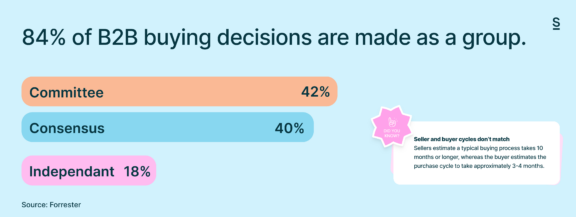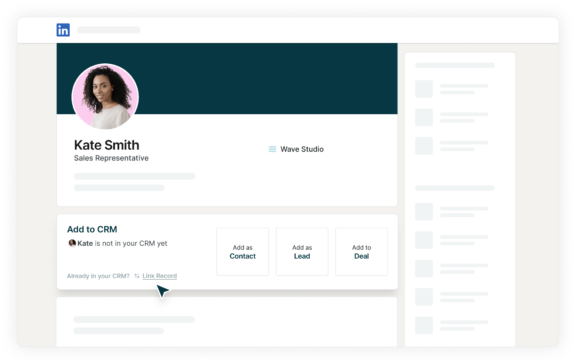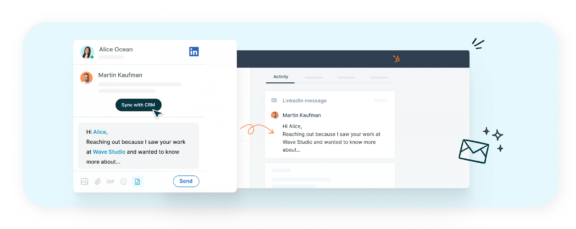How the Buying Group is Evolving

Placing the buyer at the center of your sales strategy is essential to getting the deal done.
But as the world of B2B evolves, so do buying groups.
And as buying groups evolve, so must your sales strategy.
It’s for these reasons that it is crucial for you to thoroughly understand the buying group and how it is evolving.
Key Highlights:
Understanding Buying Groups
Buying groups, in the B2B context, are the people within a company who are responsible for making purchasing decisions for new products or services. They can be composed of various stakeholders, roles, and levels of authority and responsibility.
Unlike the traditional sales model that mostly focused on individual decision-makers, the modern B2B buying process is more complex.
Salespeople must have the versatility to sell to multiple individuals with varying needs and concerns within one company.

Buying Groups are Growing
The size and complexity of buying groups is potentially their most significant evolution. The number of people involved in the purchasing process has significantly increased.
Traditionally, B2B sales would have been made by convincing one key stakeholder. But now, there can be an average of 6 to 10 individuals involved in the purchasing decision.
The size of the buying group varies from company to company, but in larger companies or more complex industries, buying groups could expand up to 15 to 16 members.
This expansion poses a challenge for sales operations: as buying groups expand, so do the complexities of sales operations.
Changes in B2B Buyer Behaviors
In recent years, there’s a noticeable shift in buyer behaviors and these too should be taken into consideration when you’re developing a strategy for addressing the concerns of buying groups.
They want more from less
As the number of software and tech tools on the market increased, naturally, the tech stacks of most organizations also grew. Tools for admin, data, planning, selling, accounting, forecasting, customer relationship management – you name it. There’s probably a tool out there for each part of your job.
But recently, we’ve started to see a contraction in this respect.
Companies were losing count of the tools in their tech stack – it costs a lot in subscriptions, costs a lot in terms of employee onboarding and training, but it also drains time away from the employees actually focussing on their priority tasks.
So now, we see that most buying groups a looking for tools that can do more.
Instead of having a tool that does X, a tool that does Y, and a tool that does Z, they want a tool that does X, Y, and Z, all in one.
Regulation is higher and so is accountability
Companies are handling an enormous amount of data nowadays. That comes with a lot of responsibility and there are rules, laws, and regulations in place to ensure certain standards.
It’s highly common for a deal to be stopped in its tracks if the product or service provider doesn’t meet certain standards that are required by the buying group’s company policy.
Even in our own case at Surfe, this is why we invested so much into our own security and committed ourselves to earning our ISO27001 certification. If a buying group is at all concerned about data security, our ISO27001 certification shows we adhere to regulations, are accountable for our actions, and hold ourselves to a high standard when it comes to data protection.

Partnerships and strategic deals are more common
Strategic partnerships and positioning your company among a certain crowd can make or break a business.
Some individuals in a buying group may have a strategic interest in purchasing your product or service. But on the contrary, some in the buying group may need convincing that your product is aligned with their strategy.
This again highlights the importance of being able to address the individual concerns of the buying group.
Adapting to these changing behaviors and closely monitoring buyer behavior is what will give you a competitive edge
Buyer personas can help you handle evolving buyer groups
Despite the importance of buyer personas in B2B sales, they remain underutilized.

So if you want to be among the high-performing organizations, you need to learn to leverage personas more effectively.
Buyer personas are semi-fictional characters that represent the characteristics, roles, responsibilities, budget, and needs of the individuals who fall into your ICP.
If you’re interested in better defining your ICP and buyer personas, you may be interested in this article:
The Impact of a New Generation of Buyers
Younger buyers carry new demands and expectations for B2B buying
Given their digital savviness, younger buyers are more likely to use self-serve transaction channels than their older counterparts. They are pushing vendors to a variety of self-serve transaction channels, including external marketplaces, app stores, vendor websites, and even through existing products.
Millennials and Gen Z buyers are active information seekers.
While there are many similarities in the way business buyers gather information across all ages, younger buyers go to more sources and find third-party resources more impactful than vendor resources. You might be tempted to provide countless case studies, one-pagers, reports, demos, and presentations, but don’t be fooled – Millennials and Gen Z have likely already done plenty of their own research.
Because of this, you should ensure that the information about your product that is available online is positive, informative, and valuable.
It’s also incredibly beneficial to craft a positive conversation around your product. Request reviews on G2, TrustPilot, and Google from your champion users. Offer incentives to leave you a 5-star review on the app stores and marketplaces you’re present on.
This group is quicker to express dissatisfaction with the buying experience.
Younger buyers are more demanding, with 90% citing dissatisfaction with their vendor in at least one area compared to 71% of older buyers. Does that mean you should spend more time addressing the resources of the younger members of the buying group? Not necessarily, but it should certainly be taken into consideration that they may need a little extra convincing.
Leveraging Tools to Sell to Buying Groups
So evolving buying groups that are larger are demanding more from sales reps.
Needing to address the pain points and concerns of a larger buying group means salespeople must prospect more people and conduct more personalized outreach.
This increase in sales operations necessitates meticulous management of data to engage with these larger groups effectively.
And it starts to make the practice of selling to these evolving buying groups rather complicated.
There’s a growing need for tools that effectively bridge the gap between identifying buying groups on platforms like LinkedIn and managing these groups within CRM systems.
If you can efficiently manage your prospection, management, and CRM data entry, the ability to sell to evolving buying groups comes as a by-product.
Additionally, outreach efforts need to be reaching the intended recipients – it’s pivotal. You cannot afford for your emails to be bouncing or landing in spam.
Surfe allows LinkedIn and your CRM to work together, intelligently and autonomously.
When using LinkedIn to identify the buying group at your target company, you can add these contacts directly to your CRM from LinkedIn.

It also means that you can sync the conversations that you’ve had with LinkedIn contacts (via message or InMail) directly into the CRM. This way, your whole team can stay updated with the different conversations going on with different individuals in the buying group and make sure you’re not crossing wires.

When the buying group is in your CRM, you need to ensure your outreach is landing in the inbox. With growing buying group sizes, increasingly complex tech stacks, and admin-heavy processes, it becomes complex to source the email addresses of all of your contacts and add them to your CRM.
Surfe’s Email Finder has a 93% find rate for verified, professional email addresses and adds them to your CRM in one click.
Let’s Wrap it Up!
Understanding and adapting to the evolving dynamics of buying groups and buyer behaviors is paramount if you want to have an edge in the B2B market. The average size of the buying group is increasing and their behaviors are changing. They’re younger and they’re a new generation that has all the resources they need to research your company at their fingertips – often so much that they prefer self-serve channels.
For sustainable growth and a competitive advantage, the highest-performing sales teams are leveraging buyer personas and the right tools to effectively engage with evolving buying groups.
Save 3 hours per week by cutting out sales admin with Surfe.
Surfe allows you to automatically sync the details, contact information, and conversations you have on LinkedIn to your CRM in one click.


